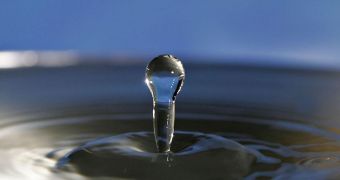The question of where water stops and where air begins is a very old, and difficult-to-answer one. Experts have been trying to do so for years, and now it would appear that they finally have an answer. The layer separating the two is as thin as the distance between two atoms in a hydrogen molecules.
At the topmost layer of water, in an ocean for example, water (H2O) molecules are having a real problem – they cannot really decided whether to exist as gas or liquid. As such, one of the two hydrogen atoms remains in the water, while the second ones pokes out into the air.
Physicists now call this the layer of molecular ambiguity, and say that it has little to no effect on the way water below this level behaves. Details of the new research were published in the June 9 issue of the top scientific journal Nature, Science News reports.
Interestingly, just one molecule beneath this first layer of H2O molecules, the rest of the water behaves as if nothing is going on in the layers above. This discovery is critically important for many fields of research, including for example atmospheric chemistry.
“In some ways this is a negative result. Sometimes a negative result can be very positive,” says Pavel Jungwirth, a scientist at the Academy of Sciences of the Czech Republic, in Prague. He wrote a commentary piece accompanying the Nature journal .
One of the most interesting aspects that could be derived from all of this is how atmospheric pollutants, such as dangerous greenhouse gases, bind to air in the atmosphere, creating long-last effects.
In the future, such an understanding could lead to the creation of advanced geoengineering techniques, meant to restore our planet's climate to its former self, before we ruined it with carbon dioxide, chlorofluorocarbons and other chemicals.
With the new data, says University of Victoria physical chemist Dennis Hore, scientists will be able to refine models seeking to explain how water interacts with other chemicals within living cells.
“Water may be the most common substance on Earth. But from a physics standpoint, it is pretty unusual,” says University of Southern California (USC), in Los Angeles scientist Alexander Benderskii, a coauthor of the study.
For many years, experts have argued that the organization of water molecules below the first layer follows an order, that makes them want to fall in line, and arrange themselves into ordered patterns.
“After the first layer [of water, all structural arrangements are] over. A lot of people still subscribe to this long-range idea. But this shows very clearly that you don’t have long-range order in water,” Jungwirth says.

 14 DAY TRIAL //
14 DAY TRIAL //